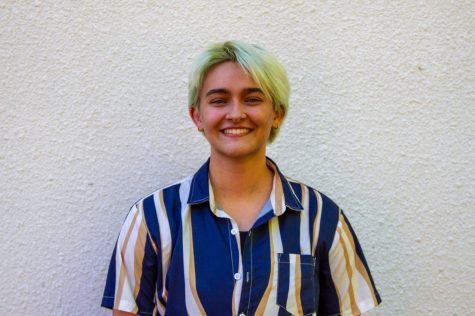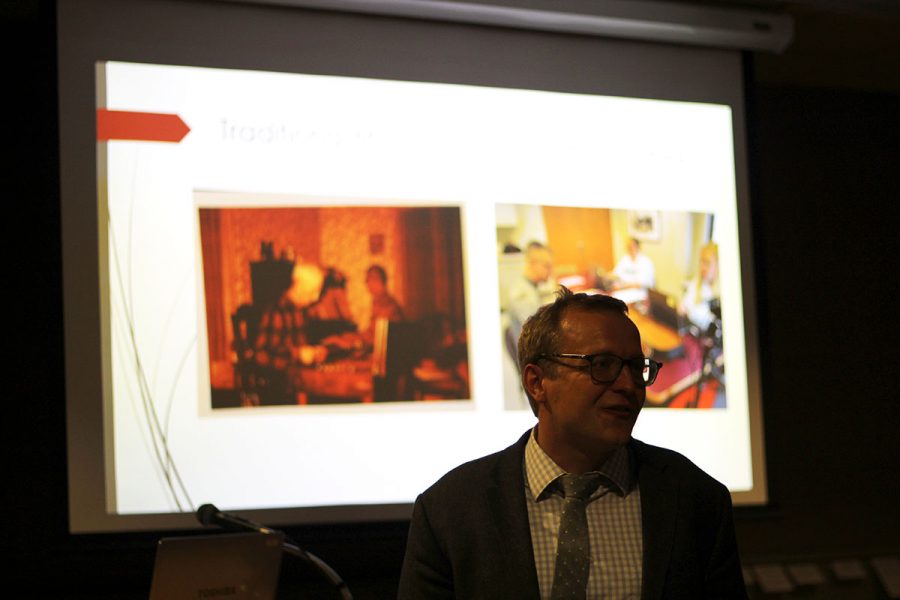Exploring Eau Claire’s rich musical past
Dan Ott presents “Making Sense of the Sounds of Eau Claire” at the Chippewa Valley Museum
Photo by Gabbie Henn
Dan Ott, students, performers and community members share their experiences of, and connections to, Eau Claire’s musical history through “The Sounds of Eau Claire.”
On Sept. 18 in the auditorium of the Chippewa Valley Museum, Dan Ott — a history professor at UW-Eau Claire — presented “Making Sense of the Sounds of Eau Claire.” The presentation explained the research and background done for his project “The Sounds of Eau Claire.
“The Sounds of Eau Claire” — which began in 2017 — is an initiative to create a digital archive of the musical history found in the Eau Claire and Chippewa Valley area.
By curating oral histories and musical artifacts, Ott and his students have made an online compilation of the artifacts and the stories tied to them. The archive comprises a wide range of musical items like posters, buttons, instruments and old gloves worn by a local performer.
“About 80 people have come in so far, with thousands of objects, and created hours of audio,” Ott said.
Ott said the idea for “The Sounds of Eau Claire” resulted from his desire to assign an oral history project to his students.
After talking with UW-Eau Claire archivist Greg Kocken, Ott said he realized music in Eau Claire would be a better research topic than his original idea of tourism. Kocken explained the prominence of Eau Claire’s music scene: its many music festivals, concerts, live music events and community music groups.
Lizzy Schmidt, a fourth-year public history student and the project manager of “The Sounds of Eau Claire,” said the first part of the project required each student involved to interview a relevant local source. Schmidt’s source, she said, was UW-Eau Claire music professor Bob Baca. They then compiled the interview into a podcast. All podcasts are available on the Converge Radio website.
Next, students began interviewing small groups of community members, Schmidt said. During these, interviewees would reference other people to contact, leading to a surplus of potential sources.
“We ended up with this insane amount of data and this insane amount of stories,” Schmidt said.
This excess resulted in the commencement of a “History Harvest” event, Schmidt said. The event, which took place March 3, allowed community members to bring artifacts in to the Chippewa Valley Museum and explain the stories behind them.
Ott said the data they’ve found so far has not been what they were initially expecting.
“We thought we’d find diverse, traditional music ways in the region going back to the 1800s and further,” Ott said. “Surprisingly, no one wanted to talk about music traditions in their family.”
Ott said he also anticipated more diversity due to the fact that about 50 percent of people living in the upper Midwest in 1800 weren’t born in the United States. Most of the artifacts gathered center around the local pop music and come from community members who were in bands themselves or were involved in the music scene in the past.
As the project progresses, Ott said he hopes they will encounter more Hmong and Native American artifacts. None have appeared yet.
Peter Phippen, a musician who attended the presentation, commented on the rich history involved with music in the area near the end of the presentation.
“Eau Claire’s always been jam-packed with musicians,” Phippen said. “The players were already here.”
Spierings can be reached at spierilp1654@uwec.edu.

Timothy Spierings is a fourth-year Spanish and journalism student. This is their eighth semester on The Spectator staff. They enjoy trying all types of new foods and listening to new music artists and are currently trying to learn the bass guitar.


